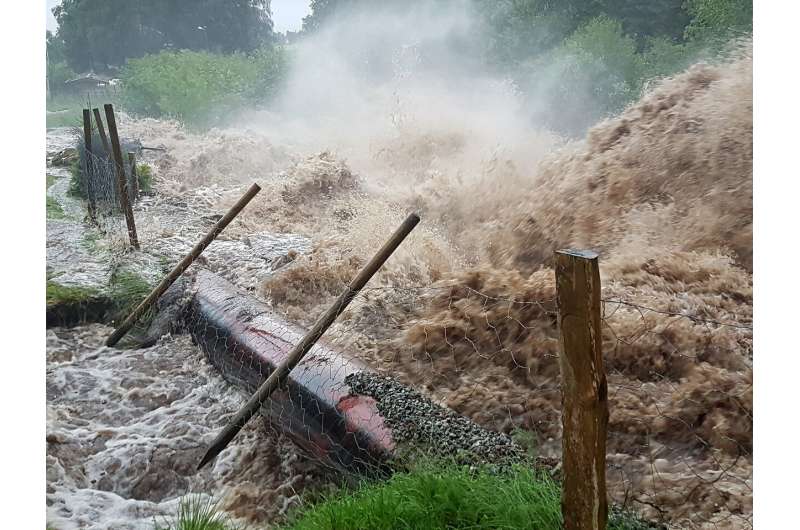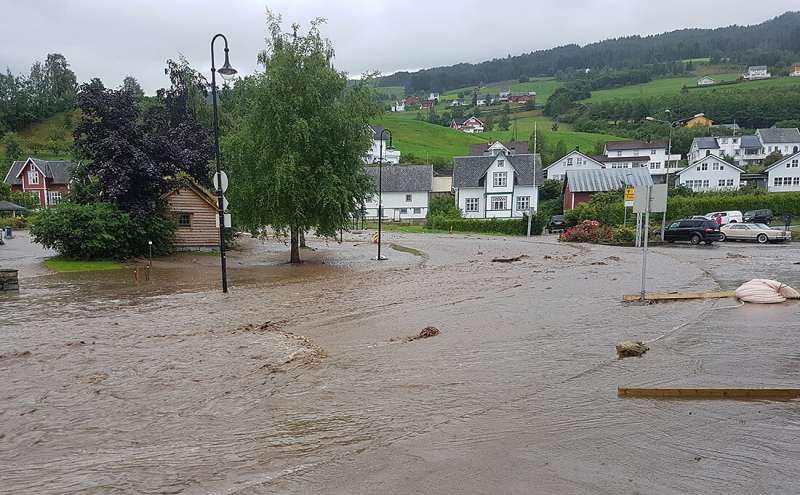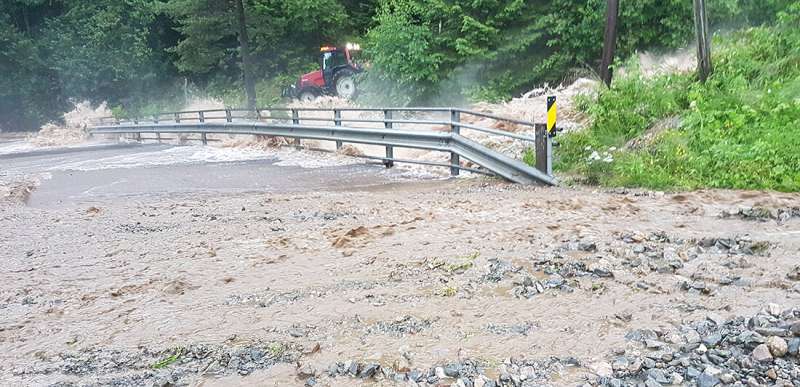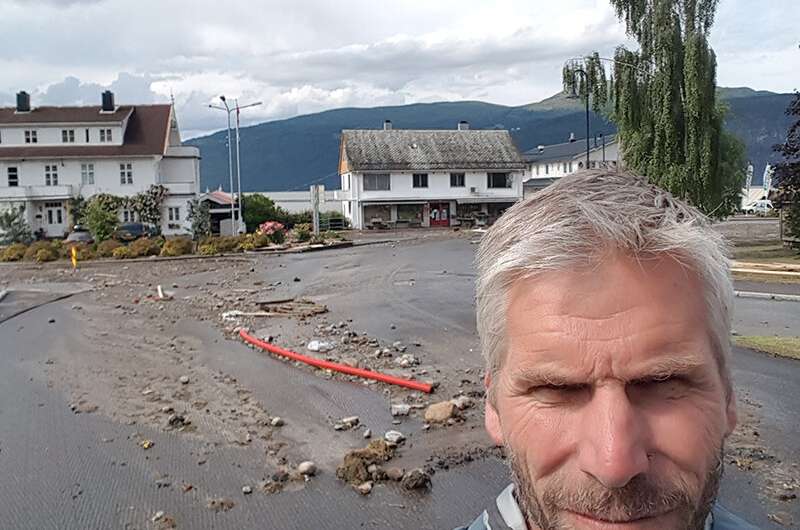Floods can be expensive and dangerous. Taking the right steps can enable simple actions to save municipalities from extensive damage, and perhaps even loss of life. Credit: Anne Jørgensen Bruland
Floods are expensive and at times dangerous. But what if a computer disaster simulation game could show politicians and local people what potential floods in their town would look like?
The summer was at its finest in Utvik village along the Nordfjord on a July morning in 2017. But then the day took an abrupt turn. Within three hours, a low-pressure system had dumped 50 millimeters of precipitation on the village. The swollen Storelva river rose at record speed, overflowed its banks and ravaged bridges, roads, buildings and most everything that stood in its way.
NTNU hydrology professor Oddbjørn Bruland was in his home town, standing in the middle of the flood in his rubber boots.
He lost his boat house and his land was destroyed, but his childhood home, the family's summer home, held its ground.
"I started thinking about kids' computer games and how amazingly well they can recreate the real world," he says, "and I wondered, 'What if we could visualize how a flood behaves with a game?'"
The year before Bruland had told the municipality and Norwegian Water Resources and Energy Directorate (NVE) that something had to be done about the river.
"But nothing happened. Maybe they would have acted faster if they'd had access to a realistic computer game that simulated the flood in Storelva?" the professor wondered.
Credit: NTNU
The flood in Utvik was the start of the NTNU project WoWW, the World of Wild Waters—not the more well-known WoW, World of Warcraft.
The goal is to create a computer game that everyone can understand. Instead of delivering a boring report, planners can create realistic flooding and landslide scenarios to show their politicians.
"Simulations can reveal where the problems lie so they can be prevented. By incorporating strategic measures into the game, like building a wall or widening a bridge opening, you can digitally observe the impacts they'll have on the flooding situation," Bruland says.
"Seeing, and almost feeling, the virtual reality effect on a screen or through VR glasses will be powerful," he says.
Lots of data out there
The WoWW game will build on existing hydrological models and automatically retrieve information on local conditions from various data sources.
For example, the Norwegian Mapping Authority (Kartverket) has laser-scanned the terrain of almost all the built-up areas in Norway. Catchment areas and 200-year floods can be calculated for anyplace you wish on the Nevina website, and rainfall information can be obtained from senorge.no.
The 2017 flooding in Utvik village. A flood can do great damage in short order. Credit: Anne Jørgensen Bruland
WoWW can also show how various measures will affect the aesthetics, and any consequences of living in and around waterways.
Bruland points out that flooding, especially in steep waterways, is also about reacting quickly when things happen. You have to know how to respond to the critical points, such as sending an excavator to prevent trees from getting stuck under a narrow bridge.
Too little knowledge
The professor believes that many municipalities are not well equipped to deal with flooding.
"Thanks to risk and vulnerability analyses (ROS), we've come quite a long way in understanding landslides in Norway, but with water things looks worse. NVE is responsible for the large, slow-flowing rivers but doesn't have the capacity to keep up with the medium-sized rivers and streams," he says.
The municipalities need to do the job themselves, and only a few have adequate expertise, according to the professor.
"WoWW is mostly focused on flooding, but the game solutions can be used for other purposes, like avalanches, fires and traffic accidents."
Quick action can be important when it really counts. Credit: Anne Jørgensen Bruland
"The need is just continuing to grow. We're already seeing signs that the climate is getting wilder and wetter," he says.
Bruland believes NTNU has an important role to play.
"Other universities have expertise in flooding and hydrology, but NTNU also has the expertise to solve engineering challenges. For example, can a bridge withstand the flood, or is it better to tear it down to save the nursing home? How can the riverbank be protected to cope with the stresses? What would be the effect of creating a basin to mitigate the water's force?" he said.
WoWW wants to create an intuitive flooding simulation that also simplifies planning.
"Hopefully, the project will increase the municipalities' interest in what could happen," Bruland says.
"At WoWW we're concentrating on floods, but we're creating an IT platform that can be a powerful tool for understanding the cause and effect of lots of situations and risk factors, such as avalanches, fires and traffic accidents," Bruland says.
Part of the backdrop for the project is former Rector Gunnar Bovim's digital transformation initiative. Five Ph.D. candidates are taking part in the project, spread across the fields of virtual reality (VR), statistics, flooding, landslides and psychology.
Professor Bruland believes that the computer simulation will increase municipalities’ interest in what could happen, so that they will take proactive steps more quickly. Credit: Norwegian University of Science and Technology
The psychologist's job is to find out what engages the user.
A doctoral thesis on particularly steep rivers and mass transport and another thesis on hydrology are also involved with the WoWW project.
Will virtual reality become a reality?
The project started in January 2019 and will continue for four years. Bruland does not envision that it will end up in final game form. The goal is to create demonstration simulations for certain waterways. The project has contacted potential stakeholders to take the technology forward to a finished product, but no agreements have yet been signed.
What is the reward when the player does well?
"Money savings for the municipality. The winnings could be huge," Bruland says with a smile.
He believes that good simulations can contribute to smart and cost-effective solutions.
"We don't need to secure entire waterways. The idea is to fix the factors that could cause the biggest and most critical problems. If we do the right things, simple actions could spare us property damage, and perhaps even loss of life. Flooding is dangerous, and people understand that," says Bruland in NTNU's Department of Civil and Environmental Engineering.
Provided by Norwegian University of Science and Technology


























